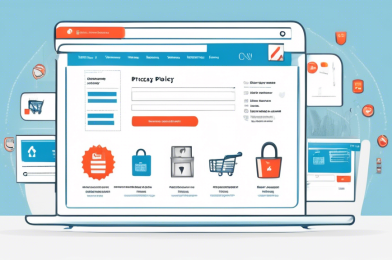Crafting an Effective Online Business Privacy Policy
Understanding the Importance of an Online Business Privacy Policy
An online business privacy policy is more than just a legal requirement—it’s a vital component in establishing trust between your business and its customers. In today’s digital age, where data breaches and privacy concerns are front and center, having a robust online business privacy policy ensures that you not only comply with laws and regulations but also build and maintain a trustworthy relationship with your audience.
Why an Online Business Privacy Policy is Crucial for Trust and Compliance
The primary purpose of an online business privacy policy is to communicate how your business collects, uses, protects, and shares personal information. Customers are increasingly wary of how their data is being handled, and a well-crafted privacy policy is a testament to your commitment to their privacy and security. It alleviates concerns and builds confidence in your brand.
Legal Requirements and Global Regulations Impacting Privacy Policies
From the General Data Protection Regulation (GDPR) in Europe to the California Consumer Privacy Act (CCPA) in the United States, global regulations mandate that businesses create transparent and comprehensive privacy policies. These laws are designed to protect consumers by ensuring that businesses are accountable for the personal data they handle, making your online business privacy policy not just a best practice but a legal necessity.
The Role of Transparency in Building Customer Trust
Transparency is key to building and maintaining customer trust. A clear and straightforward online business privacy policy shows customers that you value their privacy and are transparent about the data practices involved. By clearly outlining how data is collected, used, and protected, you can reassure customers that their personal information is in safe hands, fostering a relationship built on trust and reliability.
Key Components of a Comprehensive Online Business Privacy Policy
Best Practices for Drafting and Implementing Your Online Privacy Policy
Crafting an effective online business privacy policy involves understanding its importance, including all necessary components, and following best practices for drafting and implementation. By doing so, you can ensure compliance with legal standards, protect your customers, and strengthen their trust in your business.
Understanding the Importance of an Online Business Privacy Policy
Why an Online Business Privacy Policy is Crucial for Trust and Compliance
An online business privacy policy is more than just a legal requirement; it is a cornerstone for building trust with your customers. In today’s digital age, users are becoming increasingly aware of their rights and the importance of data privacy. When you clearly articulate how you collect, use, and protect customer information, it demonstrates a commitment to their security and privacy. This assurance can turn casual visitors into loyal customers, as they feel safer and more respected when interacting with your business.
Moreover, a robust online business privacy policy ensures that your company complies with various data protection regulations, thus avoiding potential legal pitfalls. A well-drafted policy not only makes good business sense but serves as a competitive advantage, marking your company as transparent and trustworthy in the eyes of discerning consumers.
Legal Requirements and Global Regulations Impacting Privacy Policies
To operate legally and ethically, your online business privacy policy must align with several international and local regulations. Key regulations include the General Data Protection Regulation (GDPR) in the European Union, the California Consumer Privacy Act (CCPA) in the United States, and the Personal Information Protection and Electronic Documents Act (PIPEDA) in Canada. Each of these regulations has stringent requirements concerning how businesses handle personal data, ranging from obtaining explicit consent to data breach notifications and the right to be forgotten.
Non-compliance can lead to severe penalties, including hefty fines and damage to your business’s reputation. Hence, your privacy policy needs to carefully outline how it adheres to these regulations, ensuring you’re not only protecting your customers but also safeguarding your business from legal repercussions. Ignorance is not an excuse in the legal landscape; being proactive in understanding and implementing these regulations is imperative.
The Role of Transparency in Building Customer Trust
Transparency is critical in creating and maintaining customer trust. Customers want to know precisely what data you are collecting, why you need it, and how it will be used. A clear and transparent online business privacy policy answers these questions, making customers feel more valued and informed. When customers understand and agree to your data practices, they are more likely to share their information willingly, knowing that their data will be handled responsibly.
Transparency involves not only detailing data collection practices but also explaining your data protection measures and the steps you take to secure their information. This builds confidence in your ability to protect their privacy. Furthermore, openly communicating any changes or updates to your privacy policy demonstrates that you are committed to keeping customers informed, reinforcing their trust over time.
In conclusion, creating an effective online business privacy policy is essential for establishing trust and compliance. By understanding its importance, adhering to legal requirements, and promoting transparency, you can protect your customers and your business, fostering a trustworthy relationship that encourages long-term success.
Key Components of a Comprehensive Online Business Privacy Policy
Having a thorough and well-structured online business privacy policy is essential for any company operating in the digital space. It not only ensures compliance with legal regulations but also builds trust with customers by safeguarding their personal information. Here are the key components your online business privacy policy should cover to be both effective and comprehensive.
Personal Information Collection and Usage Details
A fundamental aspect of your privacy policy is to clearly explain what personal information you collect from users and how it will be used. This section should include:
- Types of Information: Explicitly state the types of data collected, such as names, email addresses, phone numbers, and payment details. This transparency helps users understand the scope of information gathered.
- Purpose of Collection: Explain why you are collecting this information, whether it is for improving user experience, processing transactions, marketing activities, or compliance with legal obligations.
- Method of Collection: Describe how the data is collected, be it through website forms, cookies, account registrations, or other means.
Being upfront about these details helps in mitigating user concerns and establishes a foundation of trust.
Data Protection and Security Measures Explained
Users are increasingly concerned about the security of their personal data. Providing a detailed overview of the steps your business takes to protect this information can significantly enhance user confidence. Key elements to include are:
- Encryption: Specify if and how you use encryption methods to protect sensitive data during transmission and storage.
- Access Controls: Detail who has access to personal information within your company and the safeguards in place to prevent unauthorized access.
- Security Practices: Outline the security practices and technologies employed, such as firewalls, secure servers, and regular security audits.
By explaining your data protection measures clearly, you can alleviate concerns about data breaches and unauthorized access, enhancing the sense of security for your users.
User Rights: Access, Modification, and Deletion of Data
Empowering users with control over their personal information is not only a best practice but often a legal requirement in many jurisdictions. Your privacy policy should address users’ rights to:
- Access Data: Provide a process for users to request access to the personal information your business holds about them. This could be through an account dashboard or by contacting your support team.
- Modify Information: Allow users to correct or update their personal information if it is inaccurate or outdated. Describe the steps they need to take to make such changes.
- Delete Data: Explain the process for users to request the deletion of their personal data. This section should also mention any conditions under which data cannot be deleted, such as for compliance with legal obligations.
By clearly defining these rights and the associated processes, you can foster a positive relationship with your users and demonstrate your commitment to their privacy and autonomy.
Incorporating these key components into your online business privacy policy helps in creating a transparent, trustworthy, and legally compliant document. Not only does this benefit your users, but it also positions your business as a responsible and reliable entity in the digital realm.
Best Practices for Drafting and Implementing Your Online Privacy Policy
Writing in Clear and Concise Language for Easy Understanding
One of the most critical aspects of crafting an online business privacy policy is ensuring it is written in clear and concise language. A well-written privacy policy invites trust and confidence from your customers because it demonstrates your commitment to protecting their personal information. Legal jargon or overly complex sentences can deter users from thoroughly understanding and engaging with the content. This increased clarity promotes transparency, enabling customers to make informed decisions about sharing their personal data.
When drafting your privacy policy, avoid using technical terms unless absolutely necessary. Instead, opt for simple, straightforward language. For example, use terms like we collect, we use, and we protect rather than more convoluted legalese. For every point, provide a brief explanation about the relevance and process, ensuring that even users with no legal background can comprehend it.
Regular Updates and Adaptations to Reflect Current Practices and Laws
Your online business privacy policy should not be a static document. As laws evolve, and as your business operations change, it is crucial to regularly update your privacy policy to reflect these changes. This adaptability is essential for both legal compliance and maintaining customer trust.
For instance, international regulations like the GDPR (General Data Protection Regulation) and CCPA (California Consumer Privacy Act) have specific demands that your privacy policy must address. Failing to comply with such regulations can result in significant fines and legal repercussions. Therefore, periodic reviews and updates to your privacy policy should be scheduled routinely—perhaps quarterly or bi-annually. Include a date stamp on your privacy policy to indicate when it was last updated, assuring your customers that they are looking at the most recent and relevant information.
Moreover, communicate these updates to your users, either through direct notifications or a prominent announcement on your website. This not only keeps your users informed but also reinforces your commitment to transparency.
Visible Placement and Accessibility: Ensuring Customers Can Easily Find Your Privacy Policy
No matter how comprehensive or well-written your online business privacy policy is, it will not serve its purpose if customers cannot easily find it. Visibility and accessibility are critical factors in effective communication of your privacy practices.
Your privacy policy should ideally be easily accessible from multiple locations on your website. Common practices include placing a link to the privacy policy in the footer of every page, incorporating it into the sign-up process, and including a link within the checkout process if applicable. The key is to ensure that customers can find your privacy policy without having to extensively search for it.
In addition to strategic placement, consider designing your privacy policy page for ease of navigation. Use headings, bullet points, and clickable links to different sections to help users quickly find the information they are seeking. Furthermore, ensure that your privacy policy is mobile-friendly, reflecting the growing number of users accessing the internet via smartphones and tablets.
By emphasizing clear language, regular updates, and easy accessibility, you can craft a privacy policy that not only complies with legal requirements but also enhances customer trust and loyalty. A thoughtful and well-implemented privacy policy stands as a testament to your business’s dedication to protecting customer data and privacy, ultimately contributing to a positive and trustworthy brand image.
Conclusion
In conclusion, having a well-crafted online business privacy policy is not just a regulatory necessity but also a cornerstone of building trust with your customers. By clearly understanding the legal requirements and the importance of transparency, businesses can create privacy policies that not only comply with global regulations but also enhance customer confidence and loyalty.
Incorporating detailed information about personal data collection, usage, and protection provides transparency, while clearly outlining user rights reinforces your commitment to customer privacy. Adhering to best practices, such as using clear language, regularly updating the policy, and ensuring its visibility, further ensures that customers are well-informed and feel secure when interacting with your business online.
By making these efforts, businesses not only safeguard themselves from potential legal issues but also foster a more trustworthy and ethical online environment. As the digital landscape continues to evolve, ongoing attention to privacy policy development and implementation will remain essential for sustained success and customer satisfaction in the online marketplace.









